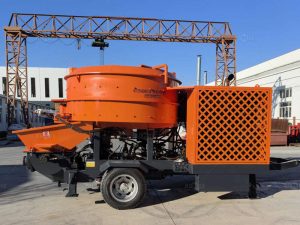The construction industry in South Africa frequently relies on efficient machinery like the concrete pump and mixer to meet the demands of various projects. These tools are indispensable for tasks that require the fast and uniform distribution of concrete. However, the hot weather conditions typical of South Africa can pose significant challenges. High temperatures can affect both the operation of machinery and the quality of the concrete mix. Therefore, understanding best practices for using a concrete pump and mixer in such environments, while ensuring safety and quality, is crucial. This guide will explore these considerations and offer practical tips to optimize operations.

Understanding the Impact of Hot Weather on Concrete Pump and Mixer Operations
Before delving into the specific tips, it’s important to understand how hot weather impacts concrete pump and mixer operations. High temperatures can accelerate the setting time of concrete, leading to potential issues with workability and finish. Additionally, excessive heat can strain machinery, increasing the risk of breakdowns and safety hazards. These challenges necessitate careful planning and execution to maintain efficiency and ensure the safety of personnel and equipment in South Africa’s climate.
Selecting the Right Concrete Pump and Mixer for South African Conditions
When searching for a concrete pump for sale South Africa, it’s essential to consider models specifically designed to withstand high temperatures. Look for pumps and mixers equipped with features such as heat-resistant components and efficient cooling systems. These adaptations can prevent overheating and extend the lifespan of the equipment. Additionally, opt for machinery that offers variable speed controls, allowing operators to adjust the mixing and pumping rates according to environmental conditions and project requirements.
Scheduling and Planning for Optimal Conditions
One effective strategy for dealing with hot weather is to plan construction activities during cooler parts of the day, such as early morning or late afternoon. This minimizes the exposure of both the concrete and machinery to extreme temperatures, reducing the risk of premature setting and equipment malfunctions. Effective scheduling also involves coordinating the delivery and use of concrete to avoid delays that could exacerbate heat-related issues. Ensure that all team members are aware of the schedule and understand the importance of timely execution to maintain quality and safety.
Preparing the Site and Equipment
Proper site and equipment preparation are critical for successful operations in hot weather. Prior to using the concrete pump and mixer, inspect all machinery to ensure it is in good working condition and adequately maintained. Check fluid levels, cooling systems, and electrical components to prevent overheating and unexpected breakdowns. On the construction site, provide shaded areas to store materials and park equipment when not in use. This can help mitigate the effects of direct sunlight and keep the concrete at a workable temperature.
Adjusting the Concrete Mix for Hot Weather
Hot weather necessitates adjustments to the concrete mix to maintain its workability and quality. Consider using admixtures that retard the setting time, allowing more flexibility during placement and finishing. Additionally, reduce the mix temperature by using chilled water or ice as part of the water content. This can help slow down the chemical reaction of cement hydration, enhancing the workability of the concrete. It’s also advisable to minimize the time between mixing and placing the concrete to prevent it from setting too quickly.
Ensuring Safety and Comfort for Workers
Ensuring the safety and well-being of workers is paramount when operating a concrete pump and mixer in South Africa’s hot weather. Provide adequate hydration and encourage regular breaks to prevent heat-related illnesses. Equip workers with appropriate personal protective equipment (PPE), such as hats, sunglasses, and sunscreen, to protect them from sun exposure. Additionally, train all personnel on the specific risks associated with operating machinery in high temperatures, emphasizing the importance of adhering to safety protocols and recognizing signs of heat exhaustion or heatstroke.
Implementing Efficient Cooling Strategies
Efficient cooling strategies can enhance the performance of a concrete pump and mixer under hot conditions. Utilize shade structures or temporary covers to protect equipment from direct sunlight, reducing heat absorption. Portable fans or misting systems can be employed to cool down the machinery and surrounding work areas. Furthermore, ensure that the equipment’s cooling systems are functioning optimally, and consider using auxiliary cooling devices if necessary. These measures can prevent overheating and improve the reliability and safety of operations.
Regular Monitoring and Maintenance
Regular monitoring and maintenance are essential for ensuring the longevity and performance of a concrete pump and mixer in hot weather. Implement a routine inspection schedule to identify and address potential issues before they lead to breakdowns. Pay attention to critical components such as hydraulic systems, hoses, and seals, as these can be particularly susceptible to heat-related wear and tear. Additionally, keep detailed records of maintenance activities and any repairs conducted, enabling proactive management of equipment health and performance.
Using a concrete pump and mixer in South Africa’s hot weather requires careful planning and execution to ensure both safety and efficiency. By selecting the right equipment, adjusting concrete mixes, and implementing effective cooling and scheduling strategies, you can optimize operations and maintain high-quality results. Prioritizing the well-being of workers and conducting regular maintenance further enhance the success of construction projects in challenging climates. With these tips in mind, you can capitalize on the capabilities of a concrete pump for sale in South Africa, achieving seamless and safe concrete placement across diverse applications.

Leave a Reply